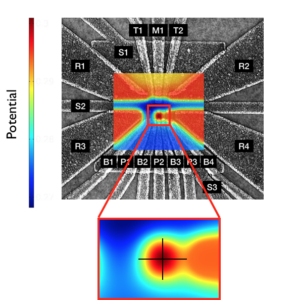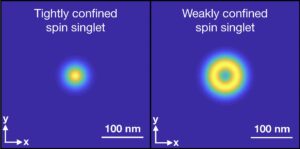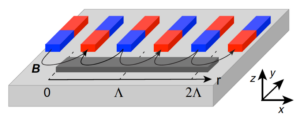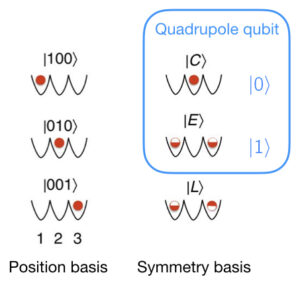Valley-orbit interactions in silicon dots

The degeneracy of the silicon conduction band minima (i.e., valleys) plays an important role in qubit operations. We study valley degeneracy in the presence of atomic-scale disorder at the quantum well interface. The image shows a single-electron wavefunction in a double-dot potential. Horizontal stripes correspond to valley oscillations, which are strongly affected by the interfacial disorder.
(Physical Review B 98, 165438)
Device simulations
Many high and low-frequency electrodes are needed to control a single quantum dot. In our research we analyze and optimize such devices, and perform high-level simulations of quantum gate operations. Detailed semi-classical simulations are employed to characterize the electrostatic environement of the devices. The results are used by both experimentalists and theorists to improve upon device operation.
(Physical Review Applied 11, 024063)

Multi-electron simulations

Quantum dots are often operated near the weak-confinement regime where electron-electron interactions play an important role in the internal dynamics of a qubit. The image shows the ground-state probability of two electrons in a symmetric, 2D confining potential, computed using the full configuration interaction method.
(Nature Physics 4, 540)
Topological qubits
Qubits are susceptible to noisy environments. Topological qubits could provide protection from this noise by exploiting exotic materials to form nonlocal logical states. We are working to construct Majorana Zero Modes (MZM) in germanium hole wires. The image shows a semiconducting wire with MZMs on each end, with engineered micromagnets to provide synthetic spin-orbit coupling.
(Physical Review B 101, 125414)

Novel qubits

For solid-state qubits, the most serious type of noise is usually electrostatic. We consider alternative schemes for mitigating the qubit-environmental couplings. The image shows a proposed quadrupole charge qubit formed in a symmetric subspace of a triple-quantum dot.
(Nature Commununications 8, 15923)
Spin-photon coupling
Spin qubits interact over very short distances (~10 nm). Large scale quantum processors will require quantum interconnects over much large distances. We explore systems involving spins in quantum dots that are coupled to microwave resonators. We quantify and optimize the performance of such hybrid systems.
(Nature Commununications 10, 5037)
